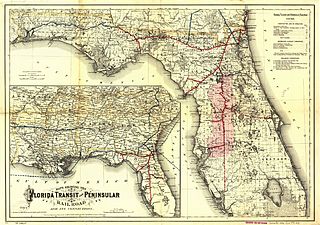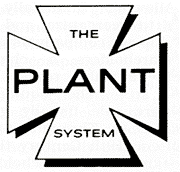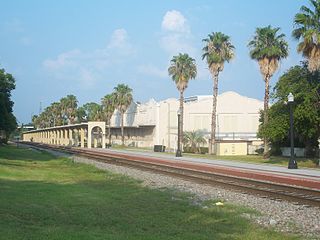
The Florida Central Railroad Company is one of several short line railroads run by Regional Rail, LLC. It runs from downtown Orlando northwest to Apopka and Tavares with a branch from Toronto to Ocoee and Winter Garden and branches from Tavares to Umatilla and Sorrento. The Florida Central connects with the Central Florida Rail Corridor in downtown Orlando, Florida and has trackage rights on the CFRC from there south to Taft Yard where they interchange with CSX Transportation. The railroad is based out of the Plymouth freight station.
The Silver Springs, Ocala and Gulf Railroad was a railroad running in northern Central Florida. Despite its name, it never directly served Silver Springs but instead ran from Ocala west to Dunnellon and to the Gulf of Mexico at Homosassa. It also had a track that served Inverness from Dunnellon.
The Florida Midland Railroad Company, Inc. is one of several short line railroads operated by Regional Rail, LLC in Florida. The Florida Midland Railroad operates two former CSX Transportation railroad lines including their former Lake Wales Subdivision, and their former Bartow Subdivision. It once had a third line from Wildwood to Leesburg that is now mostly abandoned. Florida Midland Railroad began operating the lines in 1987 and uses locomotives branded for the Florida Central Railroad, its sister railroad.
The Florida Northern Railroad Company, Inc. is one of several short line railroads run by Regional Rail, LLC. It has connections to CSX at Ocala, Florida, running north to Lowell, Florida, and south to Candler, Florida. It was formerly run by CSX as their Ocala Subdivision.

The Florida Central and Peninsular Railroad was the final name of a system of railroads throughout Florida, becoming part of the Seaboard Air Line Railway in 1900. The system, including some of the first railroads in Florida, stretched from Jacksonville west through Tallahassee and south to Tampa. Much of the FC&P network is still in service under the ownership of CSX Transportation.

The Plant System, named after its owner, Henry B. Plant, was a system of railroads and steamboats in the U.S. South, taken over by the Atlantic Coast Line Railroad in 1902. The original line of the system was the Savannah, Florida and Western Railway, running across southern Georgia. The Plant Investment Company was formed in 1882 to lease and buy other railroads and expand the system. Other major lines incorporated into the system include the Savannah and Charleston Railroad and the Brunswick and Western Railroad.

Withlacoochee State Trail is a 46-mile (74 km) long paved, multi-use, non-motorized rail trail in Florida located in Citrus, Hernando and Pasco counties. It follows along the Withlacoochee River and passes through the Withlacoochee State Forest. It is the longest paved rail trail in Florida.
The Florida Southern Railway was a railroad that operated in Florida in the late 1800s. It was one of Florida's three notable narrow gauge railway when it was built along with the South Florida Railroad and the Orange Belt Railway. The Florida Southern was originally chartered to run from Lake City south through central Florida to Charlotte Harbor. However, with the influence of Henry B. Plant, it operated with two discontinuous segments that would be part of the Plant System, which would later become part of the Atlantic Coast Line Railroad.
The Orange Belt Railway was a 3 ft narrow gauge railroad established in 1885 by Russian exile Peter Demens in Florida. It was one of the longest narrow gauge railroads in the United States at the time of its completion in 1888, with a mainline 152 miles (245 km) in length between Sanford and St. Petersburg. It carried citrus, vegetables, and passengers; and it interchanged with two standard gauge lines: the Jacksonville, Tampa and Key West Railway at Lake Monroe, and the Florida Central and Peninsular Railroad at Lacoochee.
Pemberton Ferry, later renamed Croom, is a ghost town in Central Florida near Brooksville, Florida and Ridge Manor, Florida. A rail line came to Pemberton Ferry in 1884. It was a rail stop by the Withlacoochee River just north of where the I-75 bridge over Croom-Rital Road and Withlacoochee State Trail is today.

CSX Transportation's Carters Subdivision is a segment of CSX's A Line running from Poinciana southwest to Lakeland. The Carters Subdivision ends just west of Downtown Lakeland at Lakeland Junction, where it continues west as the Lakeland Subdivision and connects to the Vitis Subdivision.

The Sanford Subdivision is a railroad line owned by CSX Transportation in Florida. The line runs along CSX's A Line from St. Johns south through Palatka to DeLand. At its north end it continues south from the Jacksonville Terminal Subdivision on the A Line and at its south end it continues south as the Central Florida Rail Corridor.
CSX Transportation's Valrico Subdivision is a railroad line in Central Florida. It serves as CSX's main route through a region of Central Florida known as the Bone Valley, which contains the largest known deposits of phosphate in the United States.
The Wildwood Subdivision is a railroad line owned by CSX Transportation in Florida. It runs along CSX's S Line from Baldwin south to Zephyrhills via Ocala and Wildwood for a total of 155.7 miles. The S Line is CSX's designation for the line that was the Seaboard Air Line Railroad main line from 1903 to 1967.
The Sanford and Indian River Railroad was a historic railroad in Central Florida running from Sanford southeast to Oviedo and Lake Charm, a distance of 20 miles. The railroad dates back to the late 1800s and parts of it are still active today.
The Live Oak, Tampa and Charlotte Harbor Railroad was a historic railroad in Florida chartered by railroad tycoon Henry B. Plant. It was built as an extension of Plant's Live Oak and Rowlands Bluff Railroad. Together, the two lines ran from Live Oak, Florida to Gainesville via High Springs. The lines were completed in 1884.

The Atlantic Coast Line Railroad’s Main Line was the backbone of the Atlantic Coast Line Railroad's network in the southeastern United States. The main line ran from Richmond, Virginia to Port Tampa just southwest of Tampa, Florida, a distance of nearly 900 miles. Along its route it passed through Petersburg, Rocky Mount, Florence, Charleston, Savannah, Jacksonville, and Orlando. With the exception of a short 61-mile segment in Greater Orlando, the entire line is still owned by the Atlantic Coast Line's successor, CSX Transportation, and is still in service as their A Line.
The Atlantic Coast Line Railroad's Lakeland—Fort Myers Line was one of the railroad company's secondary main lines in Central and Southwest Florida. It was built incrementally in the late 1800s and early 1900s. Parts of the line are still active today.
The Atlantic Coast Line Railroad's DuPont—Lakeland Line was a historic rail line in southern Georgia and the northern west coast of Florida. On employee timetables, the line was actually divided into the DuPont—High Springs Line and the High Springs—Lakeland Line. The line was primarily used for freight, though some passenger services ran on parts of it in Florida. While parts of the line were built as early as 1863, the full line was not complete until 1913. Parts of the line in Florida are still active today.
The Atlantic Coast Line Railroad's High Springs—Croom Line was a historic rail line in northern Florida. The line dates back to the late 1800s and was used for both passengers and freight.











